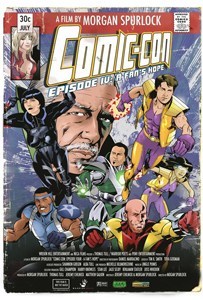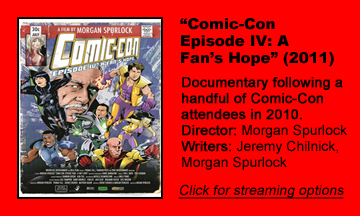“Comic-Con Episode IV: A Fan’s Hope” (2011) chronicles a slice in time in the history of San Diego Comic-Con International, held over four days every July. In 2010, as director/co-writer Morgan Spurlock follows five convention-goers, the event still features comic-book dealers, but it’s certainly a step into its commercial era where studios get to test film clips and fans get to be the first to experience a taste.
The 88-minute documentary only pays lip service to the convention’s history, which dates back to a gathering of 300 people in 1970, instead focusing on the modern mass of geek humanity.
A tame exploration
Considering that Spurlock made the memorable “Super Size Me” (2004), illustrating the effects of McDonald’s food on his body, “A Fan’s Hope” is decidedly tame.
The five focal subjects are not wildly memorable, although all are easy to watch. To keep things from getting stale, the documentary peppers in clips of celebrities such as Kevin Smith and Joss Whedon riffing about the Con and wider geek culture at the beginning of what became the Decade of the Superhero.
The biggest revelation for me is that the Comic-Con of 2010 includes a job fair, and Spurlock lucks out by choosing to follow one amateur artist, military man Eric, whose portfolio is adored by the professionals, and another, bartender Skip, who is told he needs to return to the drawing board.
I also enjoyed the peek into Mile High Comics, a vendor I have bought from on the internet. We sense through owner Chuck that comic sales is a tough business.
But at the same time, he has a “Red Raven” No. 1 that he’s listing at $500K. If he can find a buyer, his business will be doing great. But on some level, he’s hoping to do well enough in overall sales that he doesn’t have to part with the prized issue.
The weakest arc is James’ story of trying to break away from his girlfriend long enough to pick up the ring he ordered, and then to propose to her at a Kevin Smith panel. Even though it is pre-arranged with Comic-Con officials, and the geek couple is likeable, it’s about as enjoyable as watching someone propose at a sporting event.
Through Smith riffing on the topic, the documentary pays lip service to the increase in female attendees as compared to the Con’s early days, but only focuses on one: cosplayer Holly. Along with her team of friends, she puts on a “Mass Effect” skit at the masquerade.
For better or worse, all five subjects are fairly normal, not just by the standards of geekdom, but by any standard. Holly and her team are prepared and focused with their professional-quality costumes.
Where are the geeks?
“A Fan’s Hope” is short on the cringe-worthy geek personalities one might fear; no one sounds like Comic Book Guy or Professor Frink (but Matt Groening is among the celebrity interview snippets). Spurlock and his team aren’t here to laugh at anyone; the subjects are treated with respect and honesty. Only Skip fails to achieve his aims, but he resolves to keep working at his art.
The documentary is missing a deeper dive into why Comic-Con grew from 300 attendees to 126,000 in 40 years (it later hit a peak of 167,000 in 2015), and how it expanded into movies, TV, toys and cosplayers. There’s no footage or still photos or audio from anything other than the 2010 event.
Chuck shares a brief note of dismay about how the “comic book” part of the event has been shunted to the side. He notes that Lucasfilm now owns the loading dock, so it’s harder to transport his products inside.
But mostly, this could play fine as a commercial for Comic-Con itself and franchise-based entertainment in general, including shots of Stan Lee and his fans fawning over each other that continue long after we’ve gotten the point. I felt like I was at Comic-Con but never wished that I was there. (Admittedly, geeking out to this degree is not my thing.)
Still, “A Fan’s Hope” nicely captures the modern Comic-Con. While there’s no shortage of YouTube footage (usually highlighting cosplayers, and especially – if they want clicks – cute female cosplayers) in recent years, it’s nice to have a crisp documentary that will serve as a time capsule after Comic-Con gets warp-speeded into the age of virtual tele-conventions.



